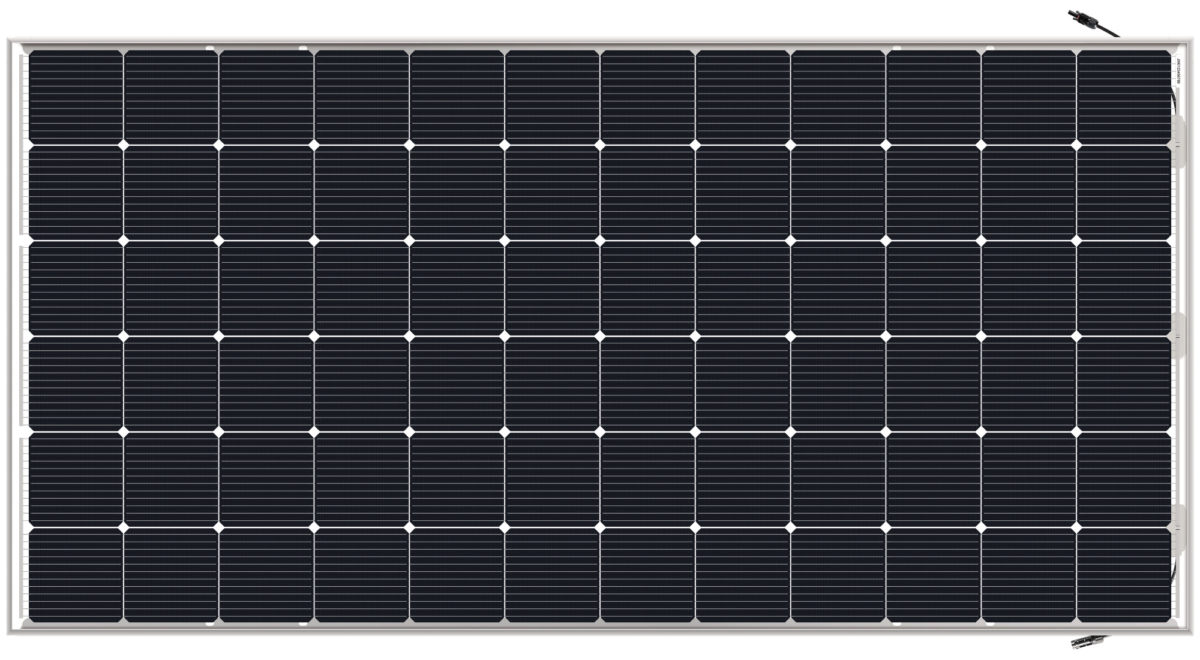The 105 MWac Amin Solar PV project in southern Oman hits a number of milestones. Not only is it the country’s first utility-scale solar array, it is also claimed to be the largest project in the world to use bifacial modules employing n-type TOPCon cell technology.
Amin was supplied by Jolywood, with the company’s International Sales Head Alfred Liu noting that the project demonstrates some of the advantages of n-type bifacial technology – particularly in testing environments like the Middle East. “Here in the Middle East, the conditions are very fierce [with temperatures] as high as 60-70 degrees Celsius on the ground,” noted Liu. Given this, n-type cell technology’s temperature co-efficient of -0.32%, compared to -0.37-0.39% for p-type, sets it apart. Bifaciality of up to 80% is also a plus. “Among bifacial, n-type technology stands out,” Liu said.
Production landscape
Jolywood itself is currently one of the leading suppliers of n-type TOPCon PV products, alongside Chinese compatriot Trina Solar. Perhaps most impressively, Jolywood guarantees a power output of 87.4% after 30 years of operation – testament to n-type’s inherent minimal susceptibility to light induced degradation (LID). As n-type cell production only requires boron doping on the technology’s very thin emitter, it is less likely to form the boron-oxygen complex, which can be a recombination center for photo-generated carriers, explained Pierre Verlinden, the former chief scientist at Trina Solar and a pv magazine award juror.
“I think that passivated contacts [TOPCon] in general is the next technology on the PV technology roadmap,” Verlinden observed, noting that heterojunction is also currently vying for this position.
TOPCon, which otherwise goes by a variety of names, is an abbreviation of Tunnel Oxide Passivated Contacts. It involves depositing a nanometer scale layer of silicon oxide, followed by a thicker polycrystalline silicon layer, between the silicon wafer and metal contacts. The layers reduce charge recombination between the wafer and the contacts, increasing carrier lifetime and resulting in a conversion efficiency boost of around 0.5%.
Approaches to deposition
One of the unanswered questions regarding TOPCon is precisely which production processes will prove to be most effective in large-scale production. The Netherlands’ Tempress has been one of the most prominent equipment providers to TOPCon producers in recent years via a long-running collaboration with TNO Energy Transition, formerly ECN – the Energy Research Centre of the Netherlands.
Tempress supplies low pressure chemical vapor deposition (LPCVD) tools for TOPCon production. In September 2018, it announced that it was supplying Trina with its LPCVD poly equipment, however there have been no follow-up orders publicly announced since. At the time, Trina itself had reported supplying around 1 GW of Top Runner projects in China with modules deploying its n-type TOPCon technology.
However, there can be downsides to LPCVD, and Trina engineers told pv magazine in December 2018 that it was experiencing frustrations in its TOPCon processes, noting that production lines can be disrupted by pipe cracks and deposition reactors becoming “dusty” with “tiny silicon particles”.
Meyer Burger is advocating plasma enhanced chemical vapor deposition (PECVD) processes for TOPCon production, through its CAiA platform. “The compact tool enables solar cell manufacturers to industrialize the TOPCon process for series production,” said Meyer Burger CTO Gunter Erfurt. “CAiA can be easily integrated in our field proven PERC system. The tool enables enhanced cell efficiencies at competitive costs.”
The potential of CAiA was recognized with it being selected as the winner of the Tools category in pv magazine’s 2019 awards. And in their deliberations, the jurors set out some of the potential advantages of PECVD for TOPCon production.
“The market impact could and should be high, because TOPCon is an upgrade to existing mono PERC lines,” noted Simon Price, the CEO of Exawatt. In providing context, Price noted that Exawatt formerly advised against atomic layer deposition (ALD) for PERC production, due to low throughput. However, once the throughput challenge was addressed, ALD quickly moved into mainstream production –based on its inherent advantages in terms of superior control of film thickness.
“So, if PECVD is an inherently better process, then you could make the argument that the productivity challenge can and will be known,” said Price.
Yali Jiang, a China-based solar analyst with BloombergNEF, noted that there will likely be a trade-off between quality and cost. “Basically, LPCVD is a thermal-driven reaction, while PECVD is a low temperature alternative,” said Jian. “In terms of throughput, LPCVD is superior, however it can result in cell defects. In terms of thin film performance, PECVD does a better job on the uniformity and the thickness, but LPCVD sounds more like a large-scale, industrial solution.”
It should also be noted that there are alternative processes being advanced for TOPCon production such as atmospheric pressure chemical vapor deposition (APCVD), which is being advanced by Schmid. There is also a sputtered approach from Von Ardenne – not to mention the work currently being undertaken by Chinese tool makers, with a LPCVD tool already available from a Chinese supplier.
While the jury, both metaphorically and literally, may be out on deposition processes for TOPCon at this stage, the technology continues to reach new heights. In November 2019, Trina claimed a world record efficiency with its n-type, crystalline silicon, i-TOPCon (industrial tunnel-oxide passivated contact) cell. The 247.79cm² cell reached a total-area front side efficiency of 23.22%. Trina reported it was achieved using a low-cost production process.
This content is protected by copyright and may not be reused. If you want to cooperate with us and would like to reuse some of our content, please contact: editors@pv-magazine.com.

